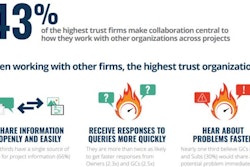
Part 4 in a series by Sue Dyer of OrgMetrics...
If I were to ask you what makes a person a leader, you are likely to say that it is the person with the top position, or the person with the right title, or that they have authority or expertise; maybe that they have the right track record. A leader is the person in charge!
These are the things that we usually think of when we think of leaders. Here’s a new perspective: there is NO LEADER without FOLLOWERS, and following is completely voluntary.
How to Build a Foundation for Partnership at Your Rental Business
7 Root Causes to Poor Communication at Your Business
5 Tips to Rise to the Highest Level of Cooperation in Business
How to Become a Trusted Leader | ForConstructionPros.com
Four Steps to Solving Your Problem
You can’t manage your team to success. It is only through leadership that your team will follow you, with a strong sense of purpose and commitment, and accomplish, together, what you set out to do. Why do people volunteer to follow? Because they TRUST the leader. When people follow they make themselves vulnerable to the leader. In order to feel comfortable with this vulnerability, they need to feel confident in, respect for and admiration of the leader. This is YOUR responsibility as the leader – to develop this type of relationship with your followers.
It is important to note that leadership is not limited to those who have authentic power. Leadership can be established at all levels of the team. Leadership is available to anyone in your organization and should be encouraged.
Continuum of leadership
There is a continuum of leadership. At one end of the spectrum is the trusted leader who develops high-trust relationships and builds a high-trust atmosphere. At the other end there is the dictator, who uses fear to drive people. Let’s look at what happens within the team under these different leadership styles.
The trusted leader - With a trusted leader people are following because they choose to do so. They feel they have a choice. When everyone on the team is there because they chose to do so, cohesion begins to develop between the team members. This leads to a sense of commitment to the team, the leader and to their mission. From this cohesion creativity begins to emerge. The team finds new ways to do things and this leads to improvement. Improvement allows the team and organization to grow and succeed.
The dictator - On the other end of the continuum is the dictator. Under a dictator people do what the leader wants because they are afraid not to. They fear that they will be punished. The coercion spreads among the team members until they too begin to coerce others. This sense of coercion leads to compliance, where people just go along. They don’t want to make waves. Compliance results in stifled communication and decision making. No one is going to tell the leader the truth. No one is going to stick his or her neck out and point out a problem. Over time, the organization and team become rigid, unable to respond to changes. Eventually the team fails and, potentially, the organization dies.
How can you build trust within your team and become a trusted leader?
Here are four steps you can start with right away.
Step #1: Stop managing and start leading - Stop managing your team (and projects) and start leading them. Managing deals with transactions. We create a schedule, develop minutes, order materials and delegate tasks. These transactions are what we DO, but they are not what make your team succeed or fail. They are the tasks of the job, which is where we focus far too often. Leading deals with transformation. Leading engages people so they become what the team needs – and not just a task performer. By focusing on transactions instead of focusing on transforming mindsets and behaviors, you undermine your team’s potential, along with your ability to teach your people how to BE successful on a team. BEING is always more powerful than doing. By focusing on developing the mindset and behavior required for success you will be heading in the right direction. Over time, the right atmosphere and attitudes always
equate to success.
Step #2: Drive out fear - Some people feel that with authority they can MAKE people follow. When you make someone do something through coercion you can’t help but to create FEAR. As stated before, if fear is the underlying motivation you don’t have leadership because no one will volunteer to follow if they are fearful. FEAR and TRUST cannot coexist – they are mutually exclusive. By definition, in order for leadership to exist, there must be high levels of trust. So as a leader you must constantly be looking for where fear exists. Even small pockets of fear can undermine the trust required for success. To combat “fear” you must create an atmosphere that allows for a dialogue to occur. This will allow the “truth” to surface in a safe fashion. Only then you can deal with the issue and work to understand the cause of the fear.
Step #3: Build trust - We’ve asked everyone on dozens of teams to tell us the level of trust on the team. There was never more than a half point difference among the responses. Everyone knows how must trust exists within the team. Trust is your critical path to success. So monitor the level of trust within your team and work to improve it. You can do this with a monthly scorecard to determine the level of trust and teamwork that is occurring. We often measure budgets, production, output, schedule… so why not the most important measure – the level of trust and how the team is working together.
Step #4: Don’t let the past predict your future - Many times we just can’t let go of something that occurred in the past. It keeps playing out in our minds and we begin to project it into the future. As a trusted leader you must not
allow the past to predict your future. You must create a strong, positive vision for your team that overcomes past problems, issues or failures. Trust (or lack of trust) is evident to everyone in a team. Part of creating a high trust culture is looking at the level of trust in your policies and transactions. This is most evident in your transactions with outsiders. Look at a sample contract. Is there “fear” built in? Are there pages and pages of boilerplate language trying to manage every potential risk? No matter how long a contract is, you can never cover all of the potential contingencies – you cannot replace trust. Look at what exists and don’t let what has occurred in the past to decide the future of your team.
Keep moving toward the trust side of the continuum
The continuum of leadership allows you to see where you need to go as a leader. You must always strive to become a trusted leader if you want to produce consistent and great results.



















